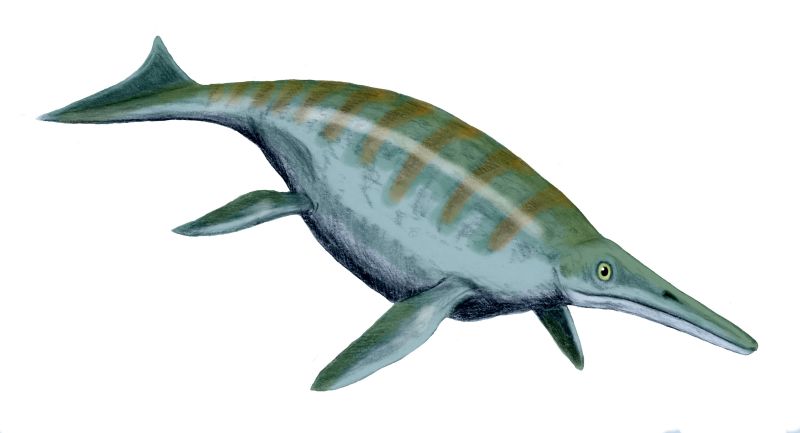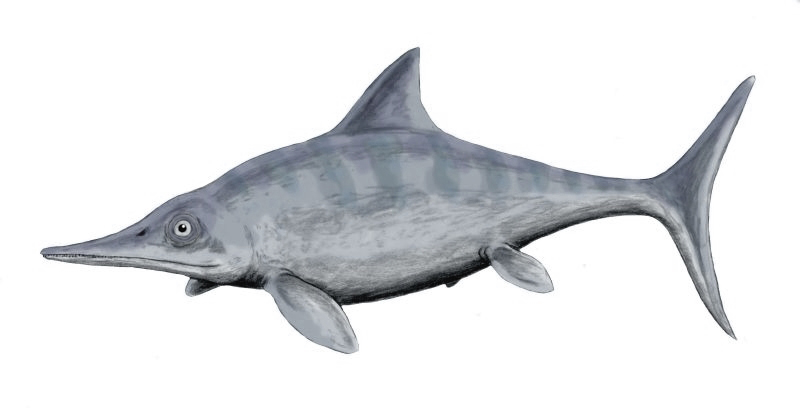The ancient oceans teemed with remarkable marine predators that evolved extraordinary adaptations for deep-water hunting. While modern creatures like sperm whales and elephant seals impress us with their diving abilities, prehistoric marine reptiles and fish developed specialized anatomical features that potentially allowed them to reach astonishing depths. From the oxygen-storing capabilities of ichthyosaurs to the pressure-resistant bone structures of mosasaurs, these ancient mariners conquered the darkest reaches of prehistoric seas. This exploration of deep-diving prehistoric creatures reveals how evolutionary adaptations enabled hunting strategies that modern marine animals continue to employ today.
The Pressure Challenge of Deep Diving

Deep diving presents extraordinary physiological challenges that increase dramatically with depth. For every 10 meters a creature descends, the pressure increases by one atmosphere, creating crushing forces that can collapse lungs and damage tissues. Prehistoric marine predators evolved specialized adaptations to counter these effects, including reinforced ribcages, flexible lung structures, and pressure-resistant blood vessels. Some species developed the ability to redirect blood flow away from non-essential organs during dives, a technique still observed in modern deep-diving mammals. These anatomical solutions emerged over millions of years of evolution, creating creatures perfectly suited to hunting in the twilight and midnight zones of ancient oceans where food resources were abundant but conditions were extreme.
Shonisaurus: The Deep-Diving Giant

Among the most impressive deep-diving prehistoric creatures was Shonisaurus, a massive ichthyosaur that reached lengths of over 50 feet. Paleontologists believe this Triassic giant could dive to extraordinary depths based on several anatomical features preserved in fossils. Its massive rib cage suggests enhanced lung capacity for storing oxygen during prolonged dives, while bone density patterns indicate resistance to deep-water pressure. Shonisaurus fossils reveal eye sockets of remarkable size – among the largest of any animal – which would have captured maximum light in the dimly lit deep ocean environments. Stomach content analysis from exceptionally preserved specimens indicates a diet rich in deep-water squid and fish species, further supporting the theory that these enormous marine reptiles were capable of hunting at significant depths where their preferred prey lived.
Ophthalmosaurus: The Deep-Sea Specialist

Ophthalmosaurus, whose name translates to “eye lizard,” possessed some of the most specialized deep-diving adaptations among prehistoric marine reptiles. Its enormous eyes – proportionally larger than those of any modern vertebrate – contained reinforced scleral rings that protected against pressure at depth while maximizing light collection in dark waters. Fossil evidence suggests these Jurassic ichthyosaurs had highly vascularized muscle tissue capable of storing significant oxygen bound to myoglobin, similar to modern deep-diving whales. Their specialized vertebral structure provided the perfect balance between rigidity for pressure resistance and flexibility for efficient swimming movements. Researchers estimate Ophthalmosaurus could remain submerged for periods exceeding an hour while hunting squid and fish at depths potentially reaching 600 meters or more, making them true specialists of the deep prehistoric oceans.
Temnodontosaurus: Built for the Deep

The Early Jurassic oceans were dominated by Temnodontosaurus, an ichthyosaur whose name means “cutting-tooth lizard.” This predator displayed remarkable adaptations for deep water hunting, including dense bones that resisted pressure changes while providing neutral buoyancy. Its body design featured a streamlined torpedo shape that minimized energy expenditure during vertical migration through the water column. Fossil evidence suggests Temnodontosaurus possessed specialized cardiovascular adaptations, including enlarged blood vessels that likely supported enhanced oxygen delivery during extended deep dives. Most telling is the preserved stomach contents from several specimens, which include remains of deep-water cephalopods and fish that only inhabit waters beyond 500 meters in modern oceans. These findings strongly suggest Temnodontosaurus regularly hunted in the mesopelagic zone, making it one of the deepest diving reptiles of its era.
Tylosaurus: The Pressure-Resistant Mosasaur

Among the late Cretaceous mosasaurs, Tylosaurus stands out as a potential deep-diving specialist that could reach lengths exceeding 40 feet. Unlike ichthyosaurs, mosasaurs descended from terrestrial lizards, requiring different adaptations for deep water pressure resistance. Tylosaurus fossils reveal dense, solid bones in the skull and vertebrae that could withstand significant pressure without collapsing. Their unique respiratory system featured reduced lungs complemented by specialized air passages that could compress safely during descent. Particularly notable was Tylosaurus’ reinforced ribcage that protected vital organs while allowing lung compression at depth. Analysis of fossilized eye structures indicates adaptations for low-light environments, suggesting these predators routinely hunted in deeper waters where visibility was limited but prey was abundant.
Platecarpus: The Twilight Zone Hunter

Platecarpus represents a fascinating case of a mosasaur specialized for hunting in the ocean’s twilight zone, depths between 200-1000 meters where light gradually diminishes. This moderately-sized mosasaur possessed a suite of adaptations suggesting regular deep-diving behavior, including unusually dense bone structure in its skull and spine. Researchers have identified specialized vascular channels in Platecarpus fossils that may have supported enhanced oxygen storage during prolonged submergence. Their vertebral structure indicates a swimming style optimized for vertical movement through the water column rather than pure speed. Most compelling are the preserved retinal structures in exceptional fossils, showing adaptations for low-light vision similar to those in modern deep-diving squid hunters. These combined adaptations suggest Platecarpus regularly ventured into deeper waters than many of its contemporaries, exploiting food resources unavailable to surface-dwelling predators.
Elasmosaurus: Long-Necked Deep Diver

The plesiosaur Elasmosaurus, with its extraordinary 23-foot neck containing 71 vertebrae, presents a unique case among potential deep-diving prehistoric reptiles. Initially, paleontologists questioned whether such anatomy would be compatible with deep diving, but closer analysis has revealed surprising adaptations. The vertebrae show specialized reinforcement that could resist compression at depth while maintaining flexibility. Their dense bone structure suggests an ability to regulate buoyancy for efficient vertical movement through the water column. Particularly revealing is the presence of specialized blood vessel channels that may have supported the “diving reflex” seen in modern marine mammals, where blood is shunted away from extremities during deep dives. Stomach content analysis reveals remains of deep-water cephalopods and fish, suggesting Elasmosaurus may have used its remarkable neck to strike with serpent-like speed in the dim waters of the deep ocean.
Dunkleosteus: The Armored Deep-Sea Predator

Predating marine reptiles by millions of years, the Devonian placoderm Dunkleosteus demonstrates that deep-diving adaptations emerged extremely early in vertebrate evolution. This 20-foot armored fish possessed a reinforced skull capable of withstanding enormous pressure, with bone density patterns suggesting regular activity at significant depths. The gills of Dunkleosteus appear to have been unusually large based on fossil impressions, potentially allowing enhanced oxygen extraction for sustained deep activity. Their body design featured specialized plates that likely provided pressure resistance while maintaining hydrodynamic efficiency. The eyes of Dunkleosteus were positioned to maximize upward visibility, a common adaptation in modern deep-water predators that hunt by silhouetting prey against the faint light from above. These combined features suggest Dunkleosteus may have been an ambush predator lurking in deeper waters before making rapid vertical ascents to capture prey.
Liopleurodon: Oxygen Storage Champion

The short-necked pliosaur Liopleurodon, made famous by exaggerated depictions in popular media, was nonetheless a remarkable potential deep diver in the Jurassic oceans. Analysis of its massive chest cavity suggests extraordinarily developed lungs with extensive capacity for oxygen storage during prolonged submergence. The bone structure of Liopleurodon shows signs of adaptation to pressure, with reinforced skeletal elements that could withstand the forces encountered at depth. Their specialized paddle-like limbs provided efficient propulsion for rapid vertical movement through different ocean layers. Blood vessel impressions in fossil specimens indicate enhanced vascular systems that may have supported the redistribution of oxygen during extended dives. Based on these adaptations and comparisons with modern deep-diving marine predators, researchers estimate Liopleurodon may have been capable of dives exceeding 600 meters when hunting for deep-water prey.
Cretoxyrhina: The Cretaceous Deep-Sea Shark

Nicknamed the “Ginsu shark” for its razor-sharp teeth, Cretoxyrhina mantelli represents one of the most formidable deep-diving fish predators of the Cretaceous seas. Unlike marine reptiles that needed to surface for air, this 20-foot shark could potentially remain at depth indefinitely, limited only by feeding requirements. Vertebral analysis shows specialized strengthening rings similar to those in modern deep-water sharks that prevent spinal compression under pressure. Exceptionally preserved specimens reveal gill structures of remarkable size that would have enhanced oxygen extraction from water at various depths. Their body design featured a reinforced skull and streamlined form optimized for both pressure resistance and energy-efficient swimming. Fossil evidence of Cretoxyrhina has been found in deep-water sediment deposits associated with mesopelagic environments, strongly suggesting these sharks regularly hunted at depths modern great whites rarely visit.
Measuring Ancient Diving Capabilities

Determining the exact diving depths of extinct marine creatures presents significant challenges, requiring multiple lines of evidence and comparative analysis. Paleontologists examine bone density patterns, as deeper-diving species typically show increased bone mass to counter buoyancy at depth, a pattern observed in modern deep-diving species. Muscle attachment sites preserved in fossils can indicate the presence of oxygen-storing myoglobin-rich tissues similar to those in contemporary deep divers like sperm whales. Eye structure analysis provides particularly valuable insights, as deep-diving species develop specialized light-gathering adaptations for low-light environments. Perhaps most compelling is the analysis of stomach contents, where the presence of prey species known to inhabit specific depth ranges in modern oceans can establish minimum diving depths for prehistoric predators. By combining these approaches, researchers continue refining our understanding of how deep ancient marine creatures could venture beneath the waves.
Oxygen Storage Adaptations

The most fundamental challenge for air-breathing deep divers is oxygen management, and prehistoric marine reptiles evolved remarkable solutions that parallel those of modern diving champions. Fossil evidence suggests many ichthyosaurs and pliosaurs possessed enlarged blood vessel channels that would have supported high volumes of oxygen-carrying hemoglobin during dives. Muscle tissue impressions in exceptional fossils indicate structures consistent with high myoglobin concentration, the specialized protein that stores oxygen in muscle tissues of deep-diving mammals today. The chest cavities of many marine reptiles show evidence of lungs with enhanced surface area for maximizing oxygen uptake during brief surfacing periods. Particularly specialized were certain ichthyosaurs whose fossilized tissues suggest they may have possessed adaptations similar to the “wonder net” vascular structures found in modern deep-diving whales, which store oxygenated blood for extended submergence. These convergent adaptations demonstrate how similar evolutionary pressures produce similar solutions across vast spans of time.
The Legacy of Deep-Diving Adaptations

The deep-diving adaptations developed by prehistoric marine creatures established evolutionary pathways that continue to influence modern ocean predators. Many of the pressure-resistance solutions first seen in ichthyosaurs and mosasaurs appear in modified form in today’s deep-diving whales and seals, representing remarkable convergent evolution across different vertebrate lineages. The specialized eye structures for low-light environments pioneered by ancient marine reptiles find parallels in modern deep-sea hunters like sperm whales and elephant seals. Oxygen storage capabilities through enhanced myoglobin concentration and specialized blood vessel arrangements originated in prehistoric divers and reached their pinnacle in today’s record-holding marine mammals. Perhaps most significant is the vertical migration hunting strategy – moving between different ocean depth zones to exploit various prey resources – which first became prominent among Mesozoic marine predators and remains a fundamental feeding strategy throughout today’s oceans. These ancient innovations continue shaping life in the deep ocean, demonstrating the enduring impact of evolutionary adaptations developed millions of years ago.
Conclusion

The prehistoric seas witnessed the evolution of marine predators with extraordinary adaptations for conquering the challenges of deep diving. From the massive Shonisaurus with its enhanced oxygen storage to the pressure-resistant Tylosaurus, these creatures developed specialized anatomical features that allowed them to exploit food resources unavailable to surface dwellers. The legacy of these deep-diving pioneers continues in modern marine mammals that employ similar strategies for hunting in the ocean depths. As paleontological techniques advance, our understanding of these ancient deep-sea specialists continues to evolve, revealing how life has repeatedly solved the challenges of pressure, oxygen management, and low-light hunting throughout the long history of marine predation.



